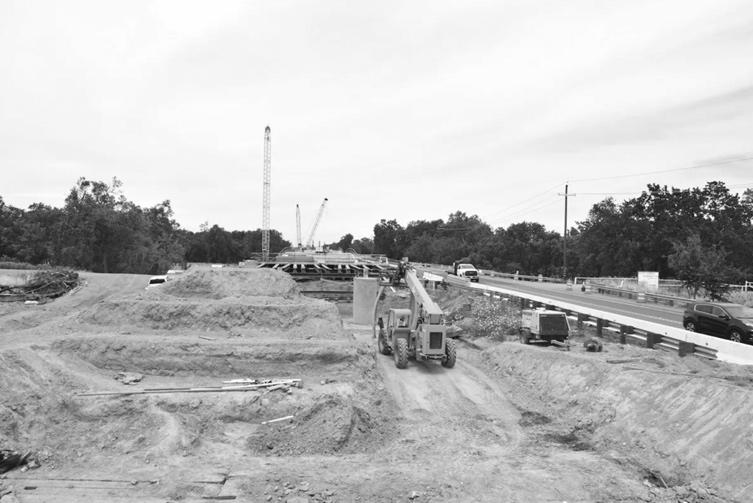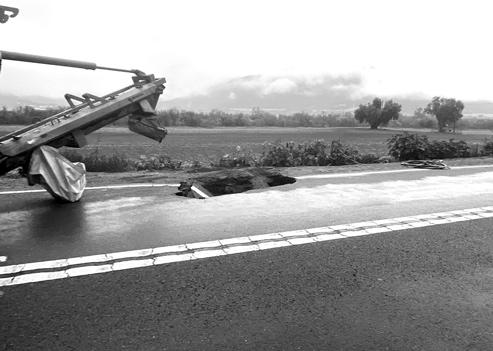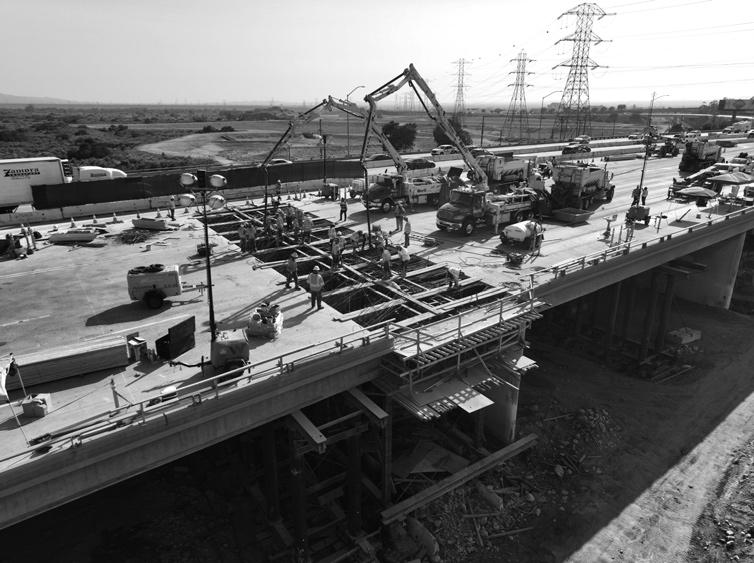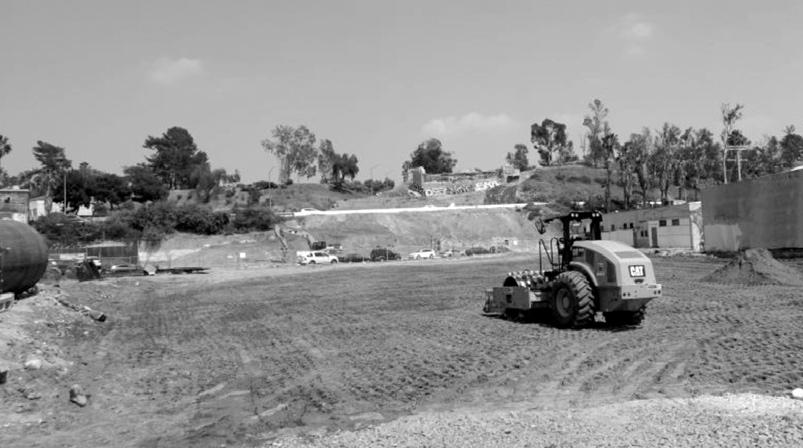February 25


February 25

The Associated General Contractors of California (AGC of California) held its annual Installation & Awards Gala, a black-tie event at the Fairmont San Francisco, on Friday, Feb. 2. During this prestigious event, the winners of the Constructor Awards and Achievement Awards were unveiled, honoring and celebrating the most outstanding contributions in the California construction industry over the past year.
“Annually, AGC of California honors the pioneers in the construction industry – those visionaries whose innovative approaches not only shape our sector but also contribute to a dynamic and continually evolving California,” said Steve Rule, 2024 AGC of California State Board president. Rule, vice president and construction executive of Turner Construction, was installed as president of AGC of California’s State Board. “These winners reflect the wide-ranging influence of construction on our state’s landscape, economy, and community.”
The prestigious Constructor Awards program acknowledges the accomplishments of AGC of California members, who demonstrate exceptional skills and successfully tackle the most complex challenges and unique undertakings. Only a single coveted Constructor Award is given in each category.


















The Associated General Contractors of California (AGC of California) recently conducted a membership survey revealing feelings of optimism among contractors toward the future of the construction industry. A positive outlook is apparent as respondents anticipate favorable financial performance and recruitment opportunities for their companies in 2024.
“The collective optimism of our members is the cornerstone driving the construction industry’s growth,” said Peter Tateishi, chief executive officer, AGC of California. “It is their confidence that fuels innovation and attracts skilled talent essential to our ever-expanding workforce. The survey serves as a barometer to gauge the optimism of our members within the industry. This insight guides us in offering tangible value through our comprehensive workforce development, robust advocacy, and leadership programs that foster inclusivity.”
Noteworthy insights from the AGC of California 2024 Optimism Survey highlight the following:

• Approximately 59 percent of survey respondents foresee growth or a moderate surge in business activities within California in 2024;
• More than 69 percent of those surveyed anticipate that the California construction sector will maintain its current pace or witness growth in expansion;
• Approximately 67 percent of respondents felt optimistic regarding the overall state of California’s construction industry, greatly surpassing the 16.8 percent who shared a less favorable view.
• Approximately 15 percent of respondents remained impartial, expressing a ‘neutral’ perspective. A strong 80 percent of respondents felt confident in the future success and potential of their own companies’ prospects in 2024.
To take advantage of upcoming market prospects, a multitude of companies are looking to bolster their workforce and enhance their bench of skilled professionals. Notably, 47.5 percent of those surveyed anticipate stepping up their recruitment efforts in 2024, with 26.7 percent planning a

slight increase, 18 percent aiming for a moderate rise and almost 2 percent preparing for a substantial upswing in hiring.
Regarding potential revenue gains, an optimistic 66 percent of companies predict that their revenue will experience an uptick in 2024 compared to the year prior — 7.6 percent foresee a significant boost, while 30.2 percent expect a moderate elevation and 27.4 percent are looking forward to a slight increase in the coming year. Conversely, 20.6 percent of firms project revenue to plateau and 14 percent anticipate a downturn.
When it comes to net profit expectations for 2024, approximately 61.3 percent of respondents are hopeful for an increase. Meanwhile, nearly 17 percent anticipate profits to stabilize without change, and 14.1 percent foresee a marginal decline.
“Despite a concern among the majority of respondents about the need for more skilled workers, a significant portion project that hiring will maintain its current pace or even rise in 2024,” Tateishi commented. “We are committed to leveraging the scope of our workforce development programs, which are crucial for equipping future employees with the skills needed in our critical industry.”
The worries surrounding California’s construction industry for the year 2024 notably revolve around a scarcity of skilled labor, with 73.7 percent expressing this concern. Stringent regulatory demands were cited by 64.2 percent, while the pressure to escalate wages and benefits was cited by 61.1 percent of respondents. When prompted to identify their primary concern, workforce pipeline development rose to the forefront for 27.4 percent of those surveyed, with regulatory issues trailing closely as the second most significant concern for 25.3 percent of respondents while, 10.5 pecent highlighted anxiety over a looming recession as their top worry.
(All photos courtesy of Caltrans.)




California was hit by two atmospheric river storms in early February that caused extensive flooding, intense winds and power outages to many regions of California, ranging from San Diego to San Francisco and the Bay Area, and as far inland as Death Valley. The record-breaking rainfalls for some part of the state led to states of emergency being declared in many counties in Southern California.
The powerful storms impacted the California Department of Transportation’s (Caltrans) network of roads, leading to landslides and mudslides, washed out roads and roads that were blocked by large amounts of debris.
In San Francisco, wind gusts of hurricane force were recorded, along with wind gusts of more than 100 miles-per-hour in the Sierra Nevada. The storms not only caused landslides, but led to many rivers overflowing. Prior to the storms hitting the state, meteorologist Reed Timmer predicted that "Biblical flooding" was a real possibility.
The first Pineapple Express storm hit between February 1 to 2, which crossed the mountains and subsequently settled over the I-25 corridor in Colorado.
The next storm hit on February 4 with such force that the National Weather Service categorized it as "potentially life-threatening", and led to Los Angeles County declaring a state of emergency.
As powerful and dangerous as the storms were, Caltrans personnel were up for the challenge and crews performed sterling work in the midst of severe weather.
“Caltrans has repaired about 1,100 potholes in Ventura and Los Angeles counties between Feb. 1 and Feb. 8,” said Comeaux. “During the storm, Caltrans maintenance
crews were on 12-hour shifts, 24 hours a day. They were ready with pumps, generators and other equipment to respond to any incidents, and they ensured reflective signs were available for traffic control needs in the event of power outages. This preparation helped crews respond to flooded highways and clear mudslides to reopen the highway back to motorists. Caltrans District 7 informed the public by posting to social media pages like Twitter/X and Instagram about closures and advising motorists not to travel due to severe winter storm event.”
District 7 experts are still assessing the damage and preparing reports to help establish an emergency repair plan that will be executed by general contractors hired for the work.
Hayden Manning, a PIO with District 11 (San Diego and Imperial counties), updated the situation and how Caltrans prepared for the arrival of the storms.
“These storms may have been the most challenging and impactful storms of the year,” he said. “While Caltrans performs maintenance year-round, these efforts are ramped up prior to weather events. State maintained culverts and drainage facilities were inspected and cleared ahead of the storm to prevent flooding. While roadway flooding was minimal, some residential areas near our facilities experienced flood conditions due to the limited capacity of the municipal infrastructure. The cities and County are working within the State of Emergency guidelines to remediate damages."
Rick Brewer, a media manager of Caltrans HQ, provided a state-wide context of the emergency and the overall response.
“During the peak of the storms, Caltrans had more than 4,000 maintenance personnel working to keep the highways and interstates open and safe,” he said. “That included removing snow, ice, fallen trees, and
debris from the roadways and culverts. In some cases, where situations force a highway or interstate to be partially or fully closed, Caltrans also hires contractors to perform emergency restorative projects so our crews can continue working to keep the rest of the state highways system functioning at its optimum levels.”
Caltrans has utilized 1,200 pieces of heavy equipment for emergency operations. At its peak, there were 69 road closures throughout the state, of which 59 had been reopened by Feb. 8. The current estimate of the damage to the state highway system is $40.1 million.
Comeaux provided an update on the situation regarding major roads. He noted that the southbound I-5 connector to southbound I-110 and the section of State Route 27 (Topanga Canyon Boulevard) that was closed from Oakwood Drive to Old Topanga Canyon Road, are now open to traffic
State Route 33 north of the city of Ojai (between Fairview Road and Lockwood Valley Road) has reopened to traffic following the removal of a mudslide that occurred during these storms and temporarily blocked all lanes.
“Nevertheless, State Route 33 between Fairview Road and Lockwood Valley Road has five locations where repairs from 2023 [last year’s)winter storms are still being constructed,” said Comeaux, “and at each of the five locations, only one lane is available. It is being used by traffic in both directions on an alternating basis.”
February 6 was a bad day for highways and roads.
“As of February 6 the rain falls brought more than 300 landslides and severe flash flooding throughout the state,” according to Wikipedia. “San Diego received record rainfall for California at higher elevations causing floods and prompting road closures. A tornado warning would be issued for portions of San Diego County by the
National Weather Service due to a severe thunderstorm produced by the storm complex, although no damage would be caused.”
On Feb. 7, it was noted that Death Valley received 1.66 in. of rain in 72 hours, which led to SR 190 being closed.
Caltrans District 7, on February 6, issued a press release on the impacts of the storm and road closures in Los Angeles and Ventura counties, and updates on the clean up and repair work. The following descriptions of road closures provide a vivid description of what Caltrans was experiencing:
State Route 1 (Pacific Coast Highway) in both directions between Las Posas Road and Sycamore Canyon Road in Ventura County will close overnight due to high tides and potential nighttime visibility issues after a right lane shoulder was partially washed out from storm-related erosion. The roadway is scheduled to open daily and close nightly through at least Saturday, unless there is additional erosion.
The southbound I-5 to southbound I-110 connector is closed due to multiple mudslides. The right lane on southbound I-5 at Stadium Way is also closed. Unknown duration.
State Route 27 (Topanga Canyon Boulevard) is closed from Oakwood Drive to Old Topanga Canyon Road due to flooding and mudslides from overflow of Topanga Creek. Unknown duration
Mudslides are blocking lanes on State Route 33 north of Ojai. SR-33 is closed in both directions between Fairview Road and Lockwood Valley Road. Unknown duration.
The far-right lane on westbound I-210 between Hubbard and Roxford streets in Sylmar is currently closed due to a sinkhole off the side of the highway. Unknown duration. CEG
(All photos courtesy of Caltrans.)
The record-breaking rainfalls in early February for some part of the state led to states of emergency being declared in many counties in Southern California. Caltrans had more than 4,000 maintenance personnel working to keep the highways and interstates open and safe.4191
916-737-7777
PIRTEK
San Leandro
1997 Burroughs Ave
San Leandro, CA 94577
510-568-5000
121 S. Maple Ave #4
South San Francisco, CA 94080
650-532-9200






AWARDS from page 1
AGC of California’s Achievement Awards honors individuals and organizations for outstanding contributions to the construction industry. The Construction Education Friend Award recognizes individuals who make exceptional contributions to construction education efforts and the development of the future construction workforce.
Additionally, the newly introduced AGC of California Owner of the Year award acknowledges an organization for outstanding partnering between the owner and the contractor.
“The recipients of this year’s awards embody the variety of ways in which individuals and their projects add value to our communities,” stated Peter Tateishi, chief executive officer of AGC of California. “Their work affects our daily commutes and creates spaces where we live, work, and play. These professionals have a profound impact on our everyday lives, and they are creating a more prosperous future in California.”
Specialty $10 Million & Over
Contractor: Royal Electric Company
Project: Waymark Walnut Creek Transit Village
Heavy Civil $15 Million & Under
Contractor: Granite Construction Company,
Project: Laguna Seca Start /Finish Bridge & Overlay Project

Heavy Civil $15 Million to $40 Million
Contractor: Flatiron
Project: San Gabriel River Bridge Hinge & Diaphragm Repairs
Heavy Civil $40 Million to $100 Million
Contractor: Myers & Sons Construction
Project: Las Gallinas Valley Sanitary
District – Secondary Treatment Plant Upgrade & Recycled Water Expansion

Heavy Civil $100 Million & Over
Contractor: Skanska
Project: Sixth Street Viaduct Replacement Project
Builder $15 Million & Under
Contractor: Swinerton
Project: DignityMoves Labath Landing
Builder $15 Million to $50 Million
Contractor: Otto Construction
Project: Mayo Hall Renovation & Addition”
Builder $50 Million to $100 Million
Contractor: Clark Construction Group
Project: Orange County Museum of Art
Builder $100 Million & over
Contractor: Hensel Phelps
Project: 1021 O Street
The AGC of California also handed out a group of additional awards to individuals who exemplified success.
Harry Eckstein Safety
Professional of Year Award
Alfredo Vargas, Walsh Construction (Retired)
S.I.R. (Skill, Integrity, Responsibility) Award
Raymond Tritt, Caltrans (Retired)
Construction Education Friend Award
Lamar Hanger, Fontana High School
Associate Achievement Award
Robert Roginson, Ogletree Deakins
Specialty Contractor Achievement Award
Henry Nutt III, Southland Industries
Contractor Achievement Award
Aaron Yohnke, California Buildings, PCL Construction
Owner of Year Award
San Bernardino County Transportation Authority (SBCTA)


The California Transportation Commission (CTC) recently allocated nearly $1.2 billion for investments for urban and rural projects throughout the state, continuing a historic push to improve the state’s vital transportation infrastructure.
The latest allocations include more than $427.7 million from the federal Infrastructure Investment and Jobs Act of 2021 (IIJA) and $164.6 million via Senate Bill 1 (SB 1), the Road Repair and Accountability Act of 2017. The CTC included $245 million for full trash capture devices, shoreline embankment restoration, improvements to bus, bicycle and pedestrian infrastructure, railroad overcrossings and better alignment with the Americans with Disabilities Act throughout the state highway system. Trash capture devices are mesh screens placed in rivers and other waterways that filter out large and small pollutants. They prevent litter from continuing downstream to bays, estuaries and the ocean.
“California is continuing to upgrade our transportation infrastructure,” said Caltrans Director Tony Tavares, “These investments will help us increase the safe, equitable and sustainable transportation access that all Californians deserve.”
The largest investment will be for a proj-
ect in the Bay Area (Alameda County, District 4), where a total of $66.4 million will be allocated in and near Pleasanton — from Route 680 to Route 238 — to rehabilitate pavement, shoulders, off- and onramps, construct concrete barrier, upgrade signs, guardrail and Transportation Management System (TMS) elements and upgrade facilities to Americans with Disabilities Act (ADA) standards.
The second largest investment is $53.1 million for State Route 2 in and near the city of Los Angeles, from Centinela Avenue to Cotner Avenue, from North La Brea Avenue to North Oxford Avenue, and from U.S. 101 to the Glendale Boulevard undercrossing. The project consists of rehabilitating pavement, construct bus pads, make bicycle and intersection improvements, modify traffic signals, upgrade curb and gutters and lighting and upgrade facilities to Americans with Disabilities Act (ADA) standards. $53.1 million.
Also in Los Angelese County, $11.46 million will be invested for State Route 1 at Big Rock Drive in Malibu. Work includes restoring shoreline embankment restoration by installing a secant pile wall to prevent erosion and flooding. A total of $16.84 million will go toward State Route 138 from State



Route 14 to Pearblossom Highway/Avenue
T in Palmdale. This project consists of upgrading curb ramps, pedestrian signals, crosswalk striping and sidewalks to meet Americans with Disabilities Act (ADA) standards. Install Class II and Class III bike lanes.
In Marin County (Bay Area, District 4), $21 million will be allocated in and near Sausalito, Larkspur and San Rafael on Routes 101, 131 and 580 at various locations to construct permanent Full Trash Capture (FTC) devices to achieve statewide National Pollutant Discharge Elimination System (NPDES) permit compliance units for trash capture.
Napa County will see a $15.5 million allocation on SR 29 to replace a culvert with reinforced concrete and to restore the drainage system.
In District 6, Wheeler Ridge CAPM (Kern County): $20.51 million will go toward rehabilitating pavement, replace sig-
nage and install Transportation Management System (TMS) elements on Interstate 5 near Grapevine, from Grapevine Road to the Route 5/99 Separation.
In Stockton (District 10), $17,668,000 will be invested for Phase 1A of the State Route 99/120 Connector Project to widen the connector ramp from eastbound State Route 120 (SR-120) to southbound State Route 99 (SR-99) near the city of Manteca. The project will widen the connector ramp from one lane to two lanes, along with removing the Austin Road overcrossing and replacing it with a four-lane structure spanning SR 99 and the Union Pacific Railroad (UPRR). The project will also be adding a new connecting road from Austin Road to East Woodward Avenue and modifying the existing UPRR gated crossing at that intersection. The project aims to improve traffic flow and will be administered by the San Joaquin Council of Governments (SJCOG).
In a boost for electric vehicle reliability, the U.S. Department of Transportation has awarded Caltrans more than $63 million in federal funds to fix and install more than 1,000 chargers at 300 sites statewide.
The $63.7 million from the federal Electric Vehicle Charger Reliability and Accessibility Accelerator (EVC RAA) grant program — part of the Infrastructure Investment and Jobs Act, also known as the Bipartisan Infrastructure Law — will replace broken charging stations and install additional chargers to meet new federal standards for public charging infrastructure.
“Thanks to the Bipartisan Infrastructure Law, California will receive nearly $64 million to improve EV charging stations across the state,” said Sen. Alex Padilla. “Accelerating the adoption of an electric vehicle powered future requires a strong, reliable, accessible charging network across the state.”
“This funding will allow California to continue to lead the nation in zero-emissionvehicle adoption, increasing reliability and cutting planet-warming pollution,” said California State Transportation Secretary Toks Omishakin. “We want to thank the Biden-Harris Administration, Sen. Alex Padilla and the state’s congressional delegation for supporting the expansion of a charging network throughout the state while combatting climate change.”
“Increasing the accessibility and standardization of EV charging stations will help us to build a more modern transportation system,” said Tony Tavares, Caltrans director. “This latest federal funding will support Caltrans in achieving its climate action goals.”
• California currently has the most electric chargers in the nation with more than 42,000;
• California leads the country in all zeroemission vehicle (ZEV) market metrics, including the largest EV market share percentage, and the most extensive public charging infrastructure;
• The success of the state’s programs has led to ZEVs becoming top export and has spurred major advances in manufacturing and job creation;
• More than 25 percent of new passenger vehicles sold in California through Q3 of 2023 were zero-emission vehicles;
• California has reached its ZEV truck sales goal two years ahead of schedule;
• This latest award comes on the heels of California’s call for projects to support $40 million in charging projects;
• Ten EV charging and hydrogen fueling projects in California, totaling $168 million, were recently awarded funding under the Federal Highway Administration’s Charging and Fueling Infrastructure Discretionary Grant Program.









